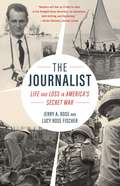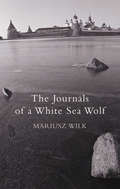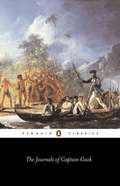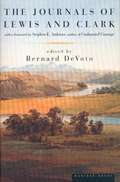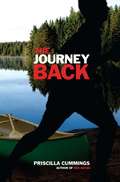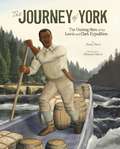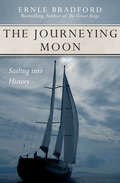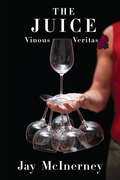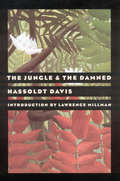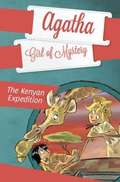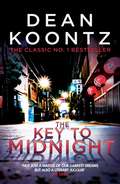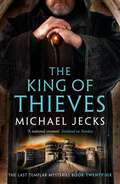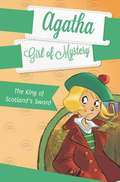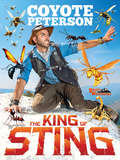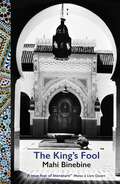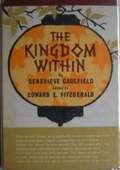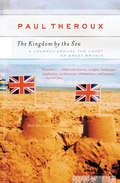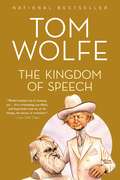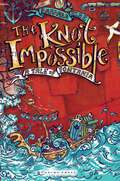- Table View
- List View
The Journalist: Life and Loss in America's Secret War
by Jerry A. Rose Lucy Rose FischerJerry Rose, a young journalist and photographer in Vietnam, exposed the secret beginnings of America&’s Vietnam War in the early 1960s. Putting his life in danger, he interviewed Vietnamese villagers in a countryside riddled by a war of terror and intimidation and embedded himself with soldiers on the ground, experiences that he distilled into the first major article to be written about American troops fighting in Vietnam. His writing was acclaimed as &“war reporting that ranks with the best of Ernest Hemingway and Ernie Pyle,&” and in the years to follow, Time, The New York Times, The Reporter, New Republic, and The Saturday Evening Post regularly published his stories and photographs. In spring 1965, Jerry&’s friend and former doctor, Phan Huy Quat, became the new Prime Minister of Vietnam, and he invited Jerry to become an advisor to his government. Jerry agreed, hoping to use his deep knowledge of the country to help Vietnam. In September 1965, while on a trip to investigate corruption in the provinces of Vietnam, he died in a plane crash in Vietnam, leaving behind a treasure trove of journals, letters, stories, and a partially completed novel. The Journalist is the result of his sister, Lucy Rose Fischer, taking those writings and crafting a memoir in &“collaboration&” with her late brother—giving the term &“ghostwritten&” a whole new meaning.
The Journals Of A White Sea Wolf
by Mariusz WilkIn 1991 Mariusz Wilk, a Polish journalist long fascinated by the mysteries of the Russian soul, decided to take up residence in the Solovki islands, a lonely archipelago lost amid the far northern reaches of Russia's White Sea. For Wilk these islands represented the quintessence of Russia: a place of exile and a microcosm of the crumbling Soviet empire. On the one hand, they were a cradle of the Orthodox faith and home to an important monastery; on the other, it was here that the first experimental gulag was built after the 1917 revolution. Over the course of years Wilk came to know every single one of the islands' 1000 or so residents. From his remote home, from which he sent regular despatches to the Paris-based Polish newspaper Kultura, he attempted to observe and come to terms with the complexities and contradictions of Russian history, its glorious past and the cruelty of Soviet Communism. In the process, he has written a most unusual travel book, a beautifully descriptive work that belongs in the best tradition of writers such as Norman Lewis, Patrick Leigh Fermor and Claudio Magris.
The Journals of Captain Cook: A Literal Transcription Of The Original Mss
by Captain James CookCook led three famous expeditions to the Pacific Ocean between 1768 and 1779. In voyages that ranged from the Antarctic circle to the Arctic Sea, Cook charted Australia and the whole coast of New Zealand, and brought back detailed descriptions of the natural history of the Pacific. Accounts based on Cook's journals were issued at the time, but it was not until this century that the original journals were published in Beaglehole's definitive edition. The JOURNALS tells the story of these voyages as Cook wanted it to be told, radiating the ambition, courage and skill which enabled him to carry out an unrivalled series of expeditions in dangerous waters.
The Journals of Lewis and Clark
by Bernard Devoto Meriwether LewisHere is your chance to travel with the great explorers Captains Meriwether Lewis & William Clark. Live experiences with them through their own words (misspellings and all) written with quill pens.
The Journey Back
by Priscilla CummingsEscaped and on the run, can Digger find redemption? His bold escape from a juvenile detention facility nearly kills him, but soon an angry fourteen-year-old Digger is on the run, hijacking a tractor trailer, "borrowing" a bicycle, and stealing a canoe. When injuries stop him, Digger hides at a riverside campground, where he befriends a young boy and a girl his own age. New friends, a job caring for rescued horses, and risking his life to save another make Digger realize that the journey back is not just about getting home, it's about discovering what he's really running from, and how to come to terms with his troubled past.
The Journey of York: The Unsung Hero Of The Lewis And Clark Expedition (Encounter: Narrative Nonfiction Picture Books Series)
by Hasan Davis Alleanna HarrisThomas Jefferson's Corps of Discovery included Captains Lewis and Clark and a crew of 28 men to chart a route from St. Louis to the Pacific Ocean. All the crew but one volunteered for the mission. York, the enslaved man taken on the journey, did not choose to go. Slaves did not have choices. York's contributions to the expedition, however, were invaluable. The captains came to rely on York's judgement, determination, and peacemaking role with the American Indian nations they encountered. But as York's independence and status rose on the journey, the question remained what status he would carry once the expedition was over. This is his story.
The Journey: Japanese Americans, Racism, and Renewal
by Sheila HamanakaText and photographed details of a mural depict the history of the Japanese people in America.
The Journeying Moon: Sailing into History
by Ernle BradfordA memoir of life as an adventurer and sailor in the Mediterranean, by the noted naval historian. Ernle Bradford spent his twenty-first birthday in Egypt, serving in the Royal Navy during World War II. It was there that he came across the profoundly affecting words of Anton Chekhov: &“Life does not come again; if you have not lived during the days that were given to you, once only, then write it down as lost.&” After the war, Bradford married and settled in London, but the mandate of those words inspired him and his wife to quit their jobs, sell their home, and sail to France in their small ship Mother Goose. The Journeying Moon chronicles their adventures as they travel through Europe and the Mediterranean. From the people of Malta who believed Bradford was a spy from MI5, to his interactions with the Sicilian Mafia, Bradford tells the charming and vivid tale of his days as a true adventurer.
The Joys of Travel: And Stories That Illuminate Them
by Thomas SwickThe Joys of Travel: And Stories that Illuminate Them is a collection of Thomas Swick’s personal essays on what he has identified as "the seven joys of travel”: anticipation, movement, break from routine, novelty, discovery, emotional connection and heightened appreciation of home.The Joys of Travel awakens readers to pleasures that, as travelers, they may be taking for granted. It also shows non-travelers what they’ve been missing. It offers tips on how people can get the most out of their trips, as well as the titles of travel classics that will not only prepare them for the places they visit but make those places more meaningful once they get there. And it tells, through memories and stories, the tale of someone who has made a living writing about travel. In fact, the story of Thomas Swick’s life as a traveler neatly parallels the examination of a journey from beginning to end.Before you next trip, be it a family vacation or a backpacking tour of Europe, read The Joys of Travel. It will inspire you to get the most out of your time away from home and to get away more often.
The Juice: Vinous Veritas
by Jay McinerneyThis new collection by the acclaimed novelist--and, according to Salon, "the best wine writer in America"--is generous and far-reaching, deeply knowledgeable and often hilarious. For more than a decade, Jay McInerney's vinous essays, now featured in The Wall Street Journal, have been praised by restaurateurs ("Filled with small courses and surprising and exotic flavors, educational and delicious at the same time" --Mario Batali), by esteemed critics ("Brilliant, witty, comical, and often shamelessly candid and provocative" --Robert M. Parker Jr.), and by the media ("His wine judgments are sound, his anecdotes witty, and his literary references impeccable" --The New York Times). Here McInerney provides a master class in the almost infinite varieties of wine and the people and places that produce it all the world over, from the historic past to the often confusing present. From such legendary châteaus as Margaux and Latour and Palmer to Australia and New Zealand and South Africa, to new contenders in Santa Rita Hills and Paso Robles, we learn about terroir and biodynamic viticulture, what Champagnes are affordable (or decidedly not), even what to drink over thirty-seven courses at Ferran Adrià's El Bulli--in all, an array of grapes and wine styles that is comprehensive and thirst inducing. And conspicuous throughout is McInerney's trademark flair and expertise, which in 2006 prompted the James Beard Foundation to grant him the MFK Fisher Distinguished Writing Award.
The Jungle and the Damned
by Lawrence Millman Hassoldt DavisHassoldt Davis (1907–1959) was an adventurer and travel writer whose work Ernest Hemingway once described as “fantastic . . . magnificent.” With his intrepid new wife, filmmaker Ruth Staudinger, Davis sets off on an improbable honeymoon, first to Devil’s Island, and then down an unexplored river in the interior of French Guiana. The result is a swashbuckling saga that deserves a place on any adventure bookshelf.
The Kenyan Expedition #8
by Maya Gold Stefano Turconi Steve Stevenson"With the smarts of Nancy Drew and the charm of Eloise, Agatha is an exciting addition to the girl-detective canon." --School Library JournalA rare species of white giraffe, worshipped by the Masai tribe, has disappeared from the savannah. So Agatha and her cousin Dash head to Africa on their next adventure to help solve the mystery. There, they join forces with a third cousin--a safari expert--to track down the poacher who has stolen the priceless animal.
The Key to Midnight: A gripping thriller of heart-stopping suspense
by Dean KoontzThe past can be a very dangerous place when it is locked into a nightmare... The Key to Midnight is a page-turning thriller from Dean Koontz that delves into the darkest of dreams. Perfect for fans of Stephen King and Harlan Coben. 'Dean Koontz writes page-turners, middle-of-the-night-sneak-up-behind-you suspense thrillers. He touches our hearts and tingles our spines' - Washington Post Book WorldWho is Joanna Rand?Alex Hunter hasn't come to Japan to fall in love. But Joanna Rand is the most beautiful, exciting woman he has ever met.But Joanna is not who she thinks she is. Ten years before, and halfway across the world, a brutally bizarre experiment recreated her mind. A violation so hideous that her dreams are filled with terror and her memories are a lie.If they are ever to be free, Alex and Joanna have to reopen the dangerous door into the nightmare past. Somehow they have to find the key to midnight... What readers are saying about The Key to Midnight: 'This is a story of suspense, action and intrigue set to the backdrop of international espionage... Koontz delivers his usual blend of mystery and action that keeps those pages turning''This is an intriguing tale, a mystery and a romance but shot through with an underlying psychological horror and also a political undertone, too''As always, so, so readable, and so, so well written'
The Kindness Diaries
by Leon LogothesisFollow the inspirational journey of a former stockbroker who leaves his unfulfilling desk job in search of a meaningful life. He sets out from Los Angeles on a vintage motorbike, determined to circumnavigate the globe surviving only on the kindness of strangers. Incredibly, he makes his way across the U.S., through Europe, India, Cambodia, and Vietnam, and finally to Canada and back to the Hollywood sign, by asking strangers for shelter, food, and gas. Again and again, he's won over by the generosity of humanity, from the homeless man who shares his blanket to the poor farmer who helps him with his broken down bike, and the HIV-positive mother who takes him in and feeds him. At each stop, he finds a way to give back to these unsuspecting Good Samaritans in life-changing ways, by rebuilding their homes, paying for their schooling, and leaving behind gifts big and small. The Kindness Diaries will introduce you to a world of adventure, renew your faith in the bonds that connect people, and inspire you to accept and generate kindness in your own life.
The Kindness of Strangers: Travel Stories That Make Your Heart Grow
by Ed Stafford Levison Wood Lois Pryce Sarah Outen Jamie McDonald Benedict Allen George Mahood Al Humphreys Anna McNuff Fearghal O'NuallainTravel is the only thing you can buy that makes you richerTravel opens our minds to the world; it helps us to embrace risk and uncertainty, overcome challenges and understand the people we meet and the places we visit. But what happens when we arrive home? How do our experiences shape us?The Kindness of Strangers explores what it means to be vulnerable and to be helped by someone we've never met before. Someone who could have walked past, but chose not to.This is a collection of stories by accomplished travellers and adventurous souls like Sarah Outen, Benedict Allen, Ed Stafford and Al Humphreys, who have completed daring journeys through challenging terrain, adventuring from the Calais Jungle to the Amazon, from Land’s End to the Gobi Desert, from New Guinea to Iran and many other places in between. Each has a story to tell of a time when they were vulnerable, when they were in need and a kind stranger came to their rescue.These are stories that make our hearts grow, stories that will restore our faith in the world and remind us that, despite what the media says, the world isn't a scary place – rather, it is filled with Kind Strangers just like us.All royalties go directly to fund Oxfam’s work with refugees.
The King Of Thieves (Last Templar Mysteries 26): A journey to medieval Paris amounts to danger
by Michael JecksOn a diplomatic mission in France, Sir Baldwin and Simon encounter more than they bargained for... Baldwin and Simon uncover a deadly assassination plot in The King of Thieves, a gripping mystery in Michael Jecks' hugely popular medieval crime series. Perfect for fans of Paul Doherty and Susanna Gregory. 'Complicated, well-populated, written with cross-cutting gusto, and accompanied by scholarly extras' - Ellery Queen Magazine1325: Sir Baldwin de Furnshill and his friend Simon Puttock are in France guarding King Edward's son on his perilous journey to meet the French king, Charles IV. But they are unaware that King Edward's wife Isabella is disaffected and plotting her revenge...What first appears a simple diplomatic mission is fast becoming lethally dangerous. Meanwhile, two murders in Paris are causing alarm. Is there a connection between the killings and the shadowy 'King' of thieves? Simon and Baldwin know the future of the English crown is at risk. And in order to protect it they must put their own lives in jeopardy. What readers are saying about The King of Thieves: 'Fast pace, intricate plot, well-drawn characters and good period feel make this a must for all fans of this genre''I cannot praise Michael Jecks' writing highly enough, his books always keep me guessing right to the end''Fantastic read - five stars'
The King of Scotland's Sword #3
by Stefano Turconi Sir Steve StevensonRumors of ancient curses and mischievous ghosts surround the disappearance of a priceless sword said to belong to the legendary Scottish King, Robert the Bruce. Determined to solve the case of this missing relic, Agatha packs her kit and heads to the Highlands!
The King of Sting (Brave Wilderness)
by Coyote Petersonp.p1 {margin: 0.0px 0.0px 0.0px 0.0px; font: 15.0px Calibri; -webkit-text-stroke: #000000} span.s1 {font-kerning: none} Wildlife expert Coyote Peterson brings his 12.5 million YouTube subscribers and legions of kid fans a highly designed, full-color exploration of his "Sting Zone" adventure series, culminating in his thrilling encounter with the "King of Sting"--the Executioner Wasp. Coyote Peterson, YouTube star, animal enthusiast, and creator of the Brave Adventure series, has tracked down some of the world's most painfully stinging insects and chronicled getting stung by each of them on his YouTube channel. Coyote has saved the best--or possibly the worst--for last, and he's finally ready to share his experience with the most painful sting in the world: the Executioner Wasp. Featuring full-color stills from his show, and packed with facts about nature's most misunderstood creatures, King of Sting is a dream book for any kid that loves animals, bugs, outdoor exploration, and danger!
The King's Fool
by Mahi BinebineSidi is dying.In the last days of this all-powerful tyrant, his faithful court fool takes stock of the decades he has spent in the king's service. For the many years have left certain indelible wounds.During his service, the fool has been the king's closest counsel, his most trusted companion and adviser, privy to the king's deepest secrets and most intimate thoughts. It is an honoured position for which many other courtiers would pay a hefty price. Something the fool understands only too well, for this closeness has indeed come at a terrible cost.What price the confidence of a great king? Is it stories, jokes, witty repartee? Or does the debt fall closer to home? Perhaps it must be paid far from the magnificent palaces, feasting and festivities of the royal court. Perhaps it must be paid in the death jails of a formidable prison fortress far out in the desert; a place so feared that few dare to speak its name . . .
The King's Fool
by Mahi BinebineSidi is dying.In the last days of this all-powerful tyrant, his faithful court fool takes stock of the decades he has spent in the king's service. For the many years have left certain indelible wounds.During his service, the fool has been the king's closest counsel, his most trusted companion and adviser, privy to the king's deepest secrets and most intimate thoughts. It is an honoured position for which many other courtiers would pay a hefty price. Something the fool understands only too well, for this closeness has indeed come at a terrible cost.What price the confidence of a great king? Is it stories, jokes, witty repartee? Or does the debt fall closer to home? Perhaps it must be paid far from the magnificent palaces, feasting and festivities of the royal court. Perhaps it must be paid in the death jails of a formidable prison fortress far out in the desert; a place so feared that few dare to speak its name . . .
The Kingdom Within
by Genevieve CaulfieldGenevieve Caulfield became blind as an infant, and was educated at the Perkins and Overbrook Schools for the Blind before attending college. When she was seventeen she became passionately interested in Japan, and determined to work there as a teacher. This memoir describes her long and careful preparations for her move to Japan, and her 14 years there as a teacher of English. In 1937, as Japan went to war in Manchuria and its relations with the United States deteriorated, Caulfield relocated to Thailand, where she established that nation's first school for blind children. Along the way Caulfield made innumerable friends, adopted a Japanese daughter, and raised her twin grandchildren after her daughter's tragic death. Life in Thailand during World War II is vividly portrayed in this memoir. This is a straightforward account by a woman of enormous determination and ability.
The Kingdom by the Sea: A Journey Around the Coast of Great Britain
by Paul TherouxThis &“interesting, insightful book&” by the author of Deep South reveals &“a side of Britain few visitors see&” (The New York Times Book Review). After eleven years as an American living in London, the renowned travel writer Paul Theroux set out to travel clockwise around the coast of Great Britain to find out what the British were really like. The result is this perceptive, hilarious record of the journey. Whether in Cornwall or Wales, Ulster or Scotland, the people he encountered along the way revealed far more of themselves than they perhaps intended to display to a stranger. Theroux captured their rich and varied conversational commentary with caustic wit and penetrating insight. &“A sharp and funny descriptive writer . . . Theroux is a good companion.&” —The Times (London)
The Kingdom of Speech
by Tom Wolfe<P>The maestro storyteller and reporter provocatively argues that what we think we know about speech and human evolution is wrong. <P>Tom Wolfe, whose legend began in journalism, takes us on an eye-opening journey that is sure to arouse widespread debate. THE KINGDOM OF SPEECH is a captivating, paradigm-shifting argument that speech--not evolution--is responsible for humanity's complex societies and achievements. <P>From Alfred Russel Wallace, the Englishman who beat Darwin to the theory of natural selection but later renounced it, and through the controversial work of modern-day anthropologist Daniel Everett, who defies the current wisdom that language is hard-wired in humans, Wolfe examines the solemn, long-faced, laugh-out-loud zig-zags of Darwinism, old and Neo, and finds it irrelevant here in the Kingdom of Speech. <P><b>A New York Times Bestseller</b>
The Knitter's Life List: To Do, To Know, To Explore, To Make
by Gwen W. SteegeKnit a traditional gansey sweater with indigo yarn. Tour a spinning mill. Discover five ways to cast on for socks. Meet your personal knitting hero. The Knitter’s Life List is a richly illustrated compilation of 1,001 experiences and adventures that devout knitters won’t want to miss. You’ll find classic techniques to master, time-honored patterns to try, unusual yarns to work with, museums to see, books to read, and much more. Get inspired and live the knitting life of your dreams!
The Knot Impossible: Rufkin's Travels in Four Acts (Tales of Fontania #4)
by Barbara ElseRufkin, a perpetual no-hoper, is left to work in a salvage yard while his celebrity parents and talented siblings go on a summer acting tour. At the salvage yard, Rufkin meets Nissy and a small boy who can only say "Help!" Soon they are caught up in a magical adventure. Bursting with humor and mystery, this is the spectacular conclusion to Barbara Else's award-winning Tales of Fontania quartet.
